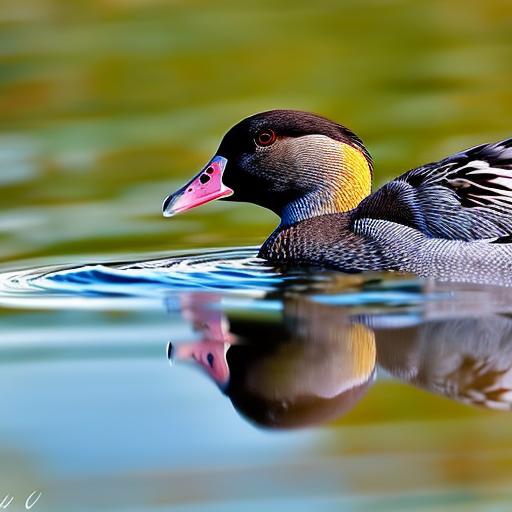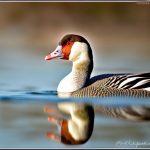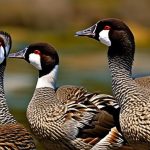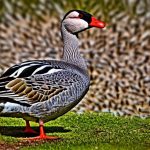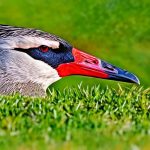Geese are highly social birds that often travel in flocks and are known for their strong family bonds. They are also known for their strong homing instincts, often returning to the same nesting and feeding grounds year after year. Geese are herbivores and are attracted to areas with abundant grass and water sources. They are also known to be territorial and can become aggressive when they feel threatened or when protecting their nests and young. Understanding these behaviors is crucial when developing strategies to deter geese from unwanted areas.
Geese are also known for their adaptability and intelligence, making them a challenging bird to deter. They are quick to learn and can become accustomed to certain deterrents over time. This means that a multi-faceted approach is often necessary to effectively deter geese from an area. By understanding the behavior of geese, property owners can develop a comprehensive plan that takes into account the birds’ social structure, feeding habits, and nesting behaviors.
Key Takeaways
- Geese are social birds that exhibit strong family bonds and are attracted to open areas near water for feeding and nesting.
- Physical barriers such as fences, hedges, and netting can effectively prevent geese from accessing certain areas.
- Decoys and scare tactics like predator silhouettes, motion-activated devices, and trained dogs can help deter geese from settling in an area.
- Modifying the landscape by adding vegetation, altering shorelines, and installing water features can make an area less attractive to geese.
- Repellents and deterrents such as taste aversions, visual deterrents, and sonic devices can discourage geese from staying in an area.
- Providing alternative habitat like designated feeding areas and nesting sites can redirect geese to more suitable locations.
- Seeking professional assistance from wildlife management experts can provide effective and humane solutions for managing geese populations.
Implementing physical barriers
One of the most effective ways to deter geese from an area is by implementing physical barriers. This can include installing fences, hedges, or other structures that prevent geese from accessing certain areas. For example, a fence around a pond or lake can prevent geese from entering the water and feeding on the vegetation around the edges. Additionally, hedges or shrubs can be planted to create barriers that discourage geese from entering certain areas.
Physical barriers can also include the use of netting or other materials to cover grassy areas where geese like to feed. This prevents the birds from accessing the grass and can encourage them to move on to other areas in search of food. When implementing physical barriers, it’s important to consider the specific behaviors of the geese in question and to create barriers that effectively deter them without causing harm.
Using decoys and scare tactics
Another effective method for deterring geese is by using decoys and scare tactics. Geese are naturally wary of predators, so placing decoy predators such as fake coyotes or dogs in the area can discourage them from settling in. Additionally, scare tactics such as loud noises, motion-activated sprinklers, or even trained dogs can be effective at keeping geese away.
Decoys can also be used in combination with other deterrent methods to create a more comprehensive approach. For example, placing decoys near physical barriers or in areas where geese like to feed can enhance the effectiveness of those barriers by adding an additional layer of deterrence. Scare tactics can also be used strategically to disrupt the geese’s routines and encourage them to seek out alternative habitats.
Modifying the landscape to deter geese
Modifying the landscape is another effective way to deter geese from an area. This can include altering the terrain to make it less attractive to geese, such as creating steep banks around bodies of water or installing gravel or rocks in areas where geese like to feed. By making the landscape less hospitable to geese, property owners can discourage the birds from settling in and encourage them to seek out more suitable habitats.
In addition to altering the terrain, modifying the landscape can also involve removing or reducing sources of food and water that attract geese. For example, reducing the amount of grassy areas or removing standing water sources can make an area less appealing to geese. By modifying the landscape in these ways, property owners can effectively deter geese without causing harm to the birds.
Utilizing repellents and deterrents
There are a variety of repellents and deterrents available that can be used to discourage geese from settling in unwanted areas. These can include chemical repellents that are applied to grass or other vegetation, as well as visual deterrents such as reflective tape or balloons. Additionally, there are sonic deterrents that emit sounds that are unpleasant to geese, as well as taste deterrents that make plants unappealing to the birds.
When using repellents and deterrents, it’s important to consider the specific needs of the property and the behavior of the geese in question. Some repellents may be more effective in certain situations than others, so it’s important to carefully evaluate the options and choose those that are most likely to be effective. Additionally, it’s important to use repellents and deterrents in combination with other methods for deterring geese in order to create a comprehensive approach.
Providing alternative habitat for geese
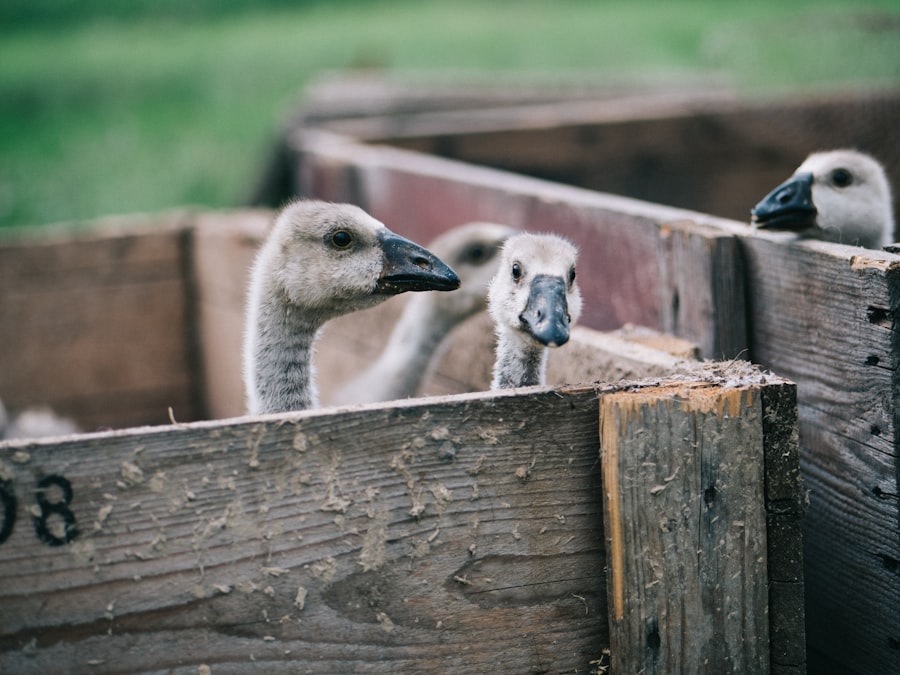
In some cases, providing alternative habitat for geese can be an effective way to deter them from unwanted areas. This can include creating designated feeding and nesting areas that are away from high-traffic or sensitive areas. By providing alternative habitat for geese, property owners can encourage the birds to settle in more suitable locations and reduce their presence in unwanted areas.
Creating alternative habitat for geese can also involve making changes to existing landscapes to make them more appealing to the birds. This can include planting native grasses and shrubs that provide food and cover for geese, as well as creating water features such as ponds or wetlands that attract the birds. By providing alternative habitat for geese, property owners can effectively deter them from unwanted areas while also supporting their natural behaviors.
Seeking professional assistance
Finally, when dealing with persistent goose problems, it may be necessary to seek professional assistance. There are wildlife management companies and professionals who specialize in deterring geese from unwanted areas using a variety of methods. These professionals can assess the specific needs of a property and develop a comprehensive plan for deterring geese that takes into account the behavior of the birds and the unique characteristics of the landscape.
Professional assistance can also be valuable for ongoing goose management, as these experts can provide regular monitoring and maintenance to ensure that deterrent methods remain effective over time. Additionally, wildlife management professionals have access to specialized tools and techniques that may not be available to property owners, making them better equipped to address persistent goose problems.
In conclusion, deterring geese from unwanted areas requires a comprehensive approach that takes into account the behavior of the birds and the unique characteristics of the landscape. By implementing physical barriers, using decoys and scare tactics, modifying the landscape, utilizing repellents and deterrents, providing alternative habitat for geese, and seeking professional assistance when necessary, property owners can effectively deter geese while supporting their natural behaviors.
Looking to keep geese away from your pond and lawn? Check out this helpful article on PoultryWizard for tips on managing geese and their eggs. It’s important to understand their behavior and breeding patterns to effectively deter them from certain areas.
FAQs
What are some effective methods to keep geese away from a pond and lawn?
Some effective methods to keep geese away from a pond and lawn include installing fencing, using decoys or scare tactics, applying repellents, and modifying the landscape to make it less attractive to geese.
How can fencing help keep geese away from a pond and lawn?
Fencing can help keep geese away from a pond and lawn by creating a physical barrier that prevents them from accessing the area. This can be particularly effective if the fencing is installed around the perimeter of the pond or lawn.
What are some examples of scare tactics that can be used to keep geese away?
Scare tactics that can be used to keep geese away from a pond and lawn include using noise-making devices, such as propane cannons or electronic sound emitters, as well as visual deterrents, such as predator decoys or reflective tape.
What types of repellents can be used to keep geese away from a pond and lawn?
Repellents that can be used to keep geese away from a pond and lawn include chemical repellents, such as methyl anthranilate, as well as natural repellents, such as grape seed extract or garlic oil.
How can the landscape be modified to make it less attractive to geese?
The landscape can be modified to make it less attractive to geese by removing or reducing the amount of open, short grassy areas, which are preferred feeding and resting spots for geese. This can be done by planting taller grasses or shrubs, or by creating natural barriers, such as berms or ditches.
Meet Walter, the feathered-friend fanatic of Florida! Nestled in the sunshine state, Walter struts through life with his feathered companions, clucking his way to happiness. With a coop that’s fancier than a five-star hotel, he’s the Don Juan of the chicken world. When he’s not teaching his hens to do the cha-cha, you’ll find him in a heated debate with his prized rooster, Sir Clucks-a-Lot. Walter’s poultry passion is no yolk; he’s the sunny-side-up guy you never knew you needed in your flock of friends!

